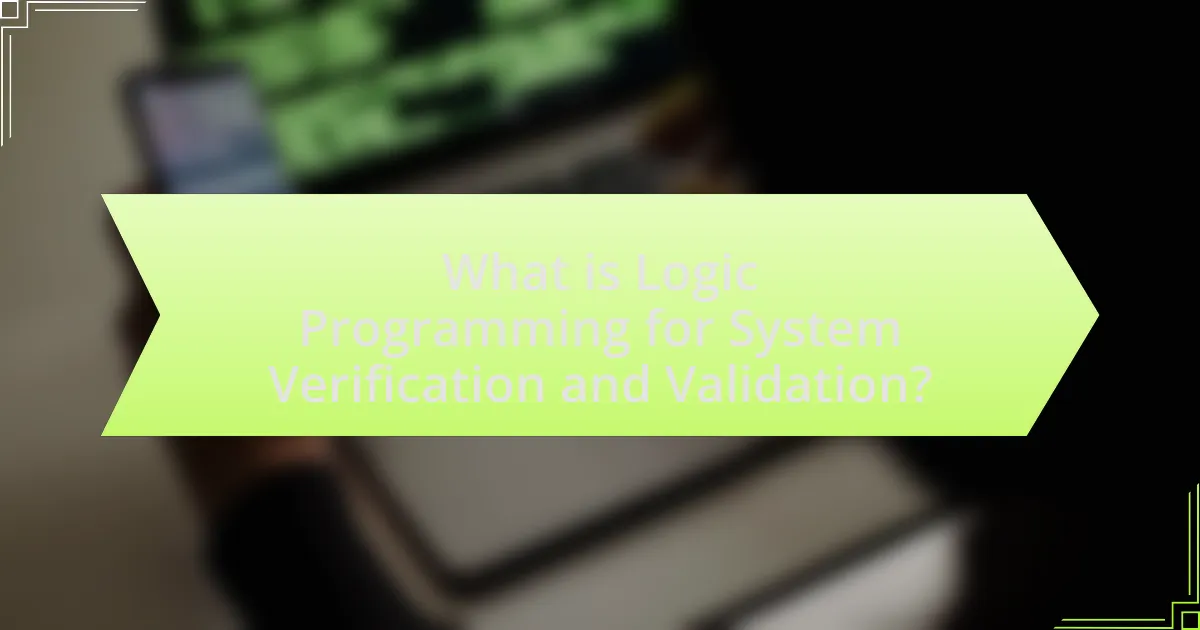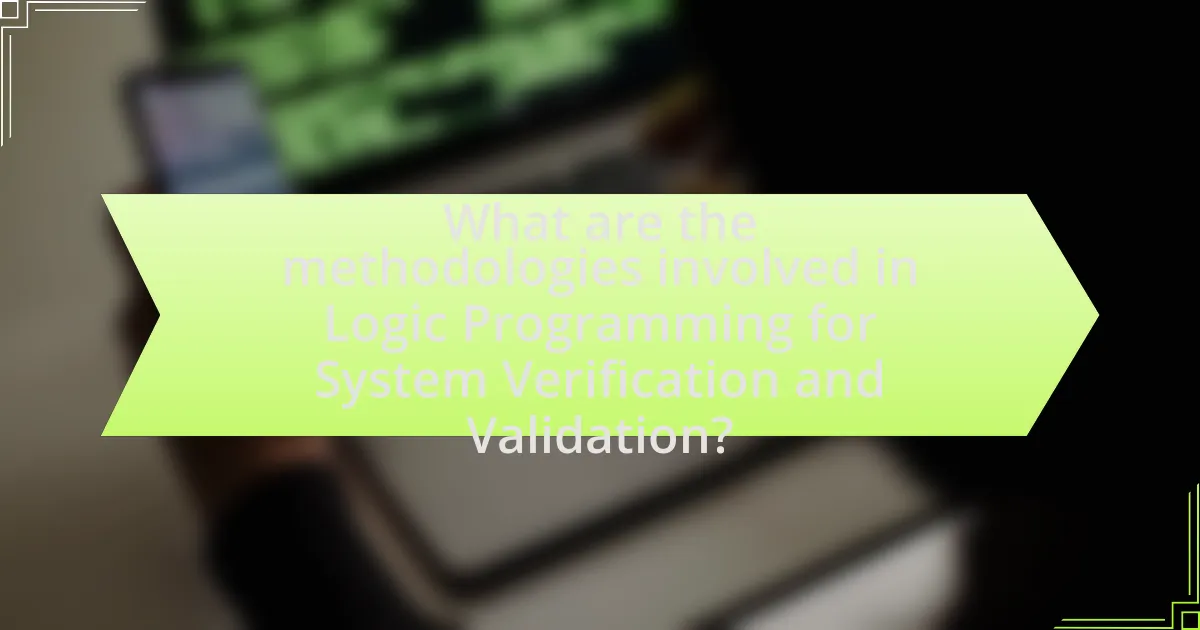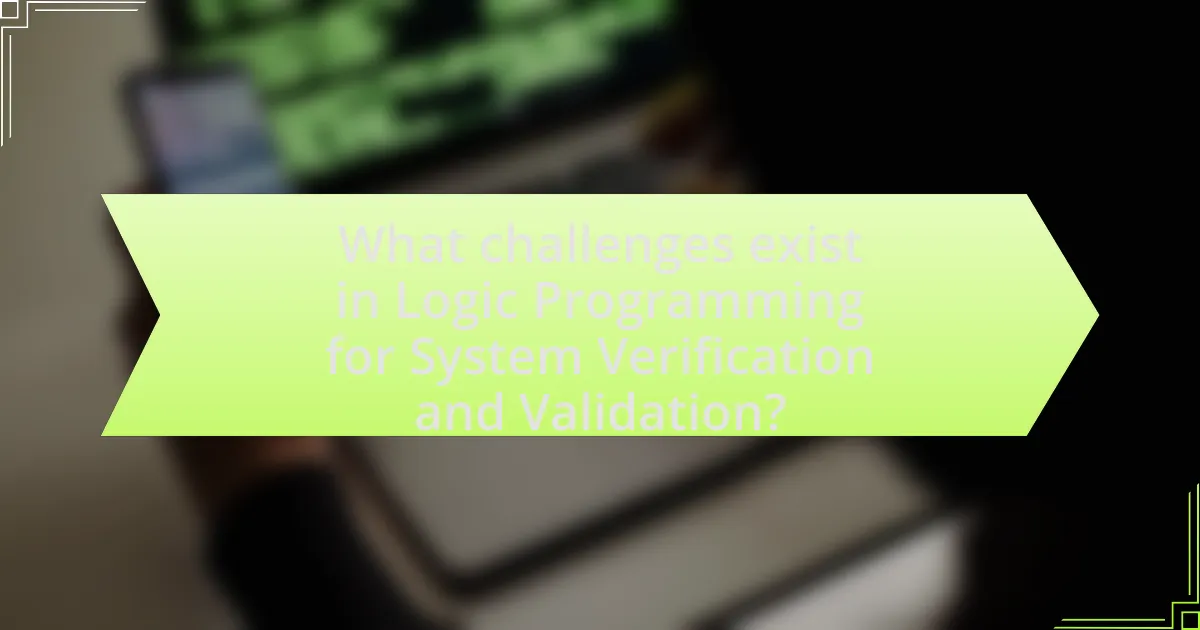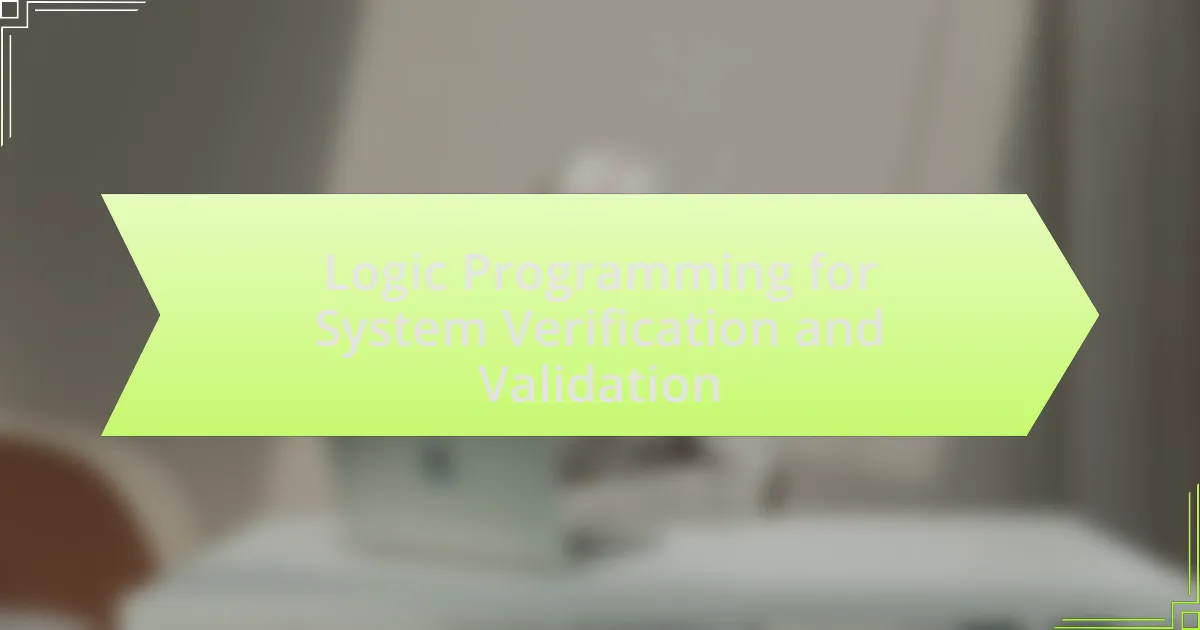Logic programming for system verification and validation is a formal method that employs logical frameworks to ensure systems meet specified requirements and function correctly. This article explores the contributions of logic programming, particularly through languages like Prolog, in automating the verification process, enhancing reliability, and addressing complex logical relationships. Key methodologies such as model checking and automated theorem proving are discussed, along with their applications in critical systems. The article also highlights the challenges and limitations of logic programming, including scalability and expressiveness, while offering best practices for effective implementation in verification tasks.

What is Logic Programming for System Verification and Validation?
Logic programming for system verification and validation is a method that utilizes formal logic to ensure that systems meet specified requirements and function correctly. This approach allows for the representation of system specifications and properties in a logical framework, enabling automated reasoning about their correctness. For instance, Prolog, a well-known logic programming language, facilitates the development of algorithms that can verify properties of software and hardware systems by expressing rules and facts about the system’s behavior. The effectiveness of logic programming in this domain is supported by its ability to handle complex logical relationships and perform exhaustive searches for counterexamples, thereby enhancing the reliability of system verification and validation processes.
How does Logic Programming contribute to System Verification and Validation?
Logic programming contributes to system verification and validation by providing a formal framework for specifying and reasoning about system properties. This framework allows for the automatic generation of proofs and counterexamples, which enhances the reliability of systems. For instance, Prolog, a prominent logic programming language, enables the representation of complex rules and relationships, facilitating the verification of system behaviors against specified requirements. Additionally, tools like model checkers utilize logic programming techniques to exhaustively explore system states, ensuring that all possible scenarios are validated. This rigorous approach reduces the likelihood of errors and increases confidence in system correctness.
What are the fundamental principles of Logic Programming?
The fundamental principles of Logic Programming include the use of formal logic as a programming paradigm, the representation of knowledge through facts and rules, and the execution of programs via a process of logical inference. Logic Programming is based on the idea that programs can be expressed as a set of logical statements, where the computation is performed by deriving conclusions from these statements using a process called resolution. This paradigm allows for declarative programming, where the focus is on what the program should accomplish rather than how to achieve it. The correctness of Logic Programming is supported by its foundation in mathematical logic, which ensures that the conclusions drawn from the given facts and rules are valid and consistent.
How does Logic Programming differ from traditional programming paradigms?
Logic programming differs from traditional programming paradigms primarily in its approach to problem-solving, emphasizing declarative rather than imperative programming. In logic programming, such as Prolog, the programmer specifies what the program should accomplish through logical statements and relationships, while traditional paradigms like procedural or object-oriented programming focus on how to achieve a task through a sequence of commands and control structures. This distinction allows logic programming to excel in areas like automated reasoning and knowledge representation, where the relationships between data are more critical than the specific steps to manipulate that data. For instance, logic programming can efficiently handle complex queries and infer new information from existing facts, which is less straightforward in traditional paradigms that require explicit instructions for each operation.
What are the key applications of Logic Programming in System Verification and Validation?
Logic programming is primarily applied in system verification and validation through automated theorem proving, model checking, and formal specification. Automated theorem proving utilizes logic programming to automatically prove the correctness of system properties, ensuring that systems behave as intended. Model checking employs logic programming to systematically explore the states of a system, verifying that all possible states meet specified requirements. Formal specification uses logic programming to define system behaviors and properties in a precise manner, facilitating rigorous validation processes. These applications enhance reliability and correctness in software and hardware systems, as evidenced by their use in critical systems like aerospace and medical devices, where verification is essential for safety and compliance.
Which types of systems benefit from Logic Programming techniques?
Logic Programming techniques benefit primarily systems that require formal reasoning, knowledge representation, and automated inference. These systems include expert systems, natural language processing applications, and database query systems. For instance, expert systems leverage logic programming to derive conclusions from a set of rules and facts, enhancing decision-making processes. Additionally, natural language processing applications utilize logic programming for semantic understanding and parsing, enabling machines to interpret human language effectively. Database query systems benefit from logic programming by allowing complex queries to be expressed in a declarative manner, facilitating efficient data retrieval and manipulation.
How is Logic Programming used in formal verification processes?
Logic programming is utilized in formal verification processes to specify and reason about system properties through logical formulas. This approach allows for the automatic verification of system behaviors against desired specifications by employing techniques such as model checking and theorem proving. For instance, Prolog, a prominent logic programming language, enables the representation of complex rules and relationships, facilitating the verification of software and hardware systems. The effectiveness of logic programming in formal verification is evidenced by its application in various domains, including safety-critical systems, where it has been used to prove the correctness of algorithms and protocols, ensuring they meet specified requirements without errors.

What are the methodologies involved in Logic Programming for System Verification and Validation?
The methodologies involved in Logic Programming for System Verification and Validation include model checking, theorem proving, and constraint logic programming. Model checking systematically explores the states of a system to verify properties against specifications, ensuring correctness through exhaustive state exploration. Theorem proving employs formal logic to derive conclusions from axioms and rules, allowing for the validation of system properties through logical deductions. Constraint logic programming integrates constraints into logic programming, enabling the specification and solving of problems by defining relationships and conditions that must be satisfied. These methodologies are foundational in ensuring that systems behave as intended and meet specified requirements.
What are the common techniques used in Logic Programming?
Common techniques used in Logic Programming include resolution, unification, and backtracking. Resolution is a rule of inference that allows for the derivation of conclusions from premises, widely utilized in automated theorem proving. Unification is the process of making different logical expressions identical by finding a substitution for their variables, essential for matching goals with rules in a logic program. Backtracking is a search algorithm that incrementally builds candidates for solutions and abandons them if they fail to satisfy the constraints, commonly applied in problem-solving scenarios. These techniques form the foundation of logic programming, enabling effective reasoning and verification in systems.
How do Prolog and other logic-based languages facilitate verification?
Prolog and other logic-based languages facilitate verification by enabling formal reasoning through their inherent logical foundations. These languages utilize a declarative approach, allowing users to specify what the system should achieve rather than how to achieve it, which simplifies the process of verifying system properties. For instance, Prolog’s backtracking mechanism allows for exhaustive search through possible states, ensuring that all potential scenarios are considered during verification. Additionally, logic-based languages support the representation of complex relationships and constraints, making it easier to model and verify system behaviors against specified requirements. This capability is evidenced by the use of Prolog in various verification tasks, such as model checking and theorem proving, where formal proofs can be generated to confirm system correctness.
What role do automated theorem provers play in this context?
Automated theorem provers play a crucial role in logic programming for system verification and validation by providing automated methods to prove the correctness of systems against specified properties. These tools analyze logical statements and derive conclusions based on formal rules, ensuring that systems behave as intended. For instance, in software verification, automated theorem provers can confirm that a program adheres to its specifications, thereby preventing errors and enhancing reliability. Their effectiveness is evidenced by their application in various domains, including safety-critical systems, where formal verification is essential to meet regulatory standards.
How do these methodologies enhance system reliability?
Logic programming methodologies enhance system reliability by enabling formal verification and automated reasoning about system properties. These methodologies allow for the precise specification of system behavior, which facilitates the identification of inconsistencies and errors during the development phase. For instance, using logic programming languages like Prolog, developers can create models that represent system requirements and constraints, ensuring that all possible states are accounted for. This rigorous approach reduces the likelihood of defects, as evidenced by studies showing that formal verification can catch up to 90% of errors before deployment.
What metrics are used to measure the effectiveness of these methodologies?
Metrics used to measure the effectiveness of methodologies in Logic Programming for System Verification and Validation include precision, recall, F1 score, and code coverage. Precision assesses the accuracy of the results produced by the methodology, while recall measures the ability to identify all relevant instances. The F1 score combines precision and recall into a single metric, providing a balance between the two. Code coverage evaluates the extent to which the code has been tested, indicating the thoroughness of the verification process. These metrics are essential for quantifying the performance and reliability of logic programming approaches in system verification and validation.
How can Logic Programming reduce errors in system design?
Logic programming can reduce errors in system design by enabling formal verification of system specifications and behaviors. This approach allows designers to express system requirements as logical statements, which can be systematically checked for consistency and correctness. For instance, Prolog, a common logic programming language, facilitates the representation of complex relationships and rules, making it easier to identify logical inconsistencies early in the design process. Studies have shown that using logic programming for verification can lead to a significant decrease in design errors, as it provides a clear framework for reasoning about system properties and behaviors, thus enhancing overall reliability.

What challenges exist in Logic Programming for System Verification and Validation?
Logic programming faces several challenges in system verification and validation, primarily due to issues related to expressiveness, scalability, and integration with other verification methods. The expressiveness challenge arises because logic programming languages may not adequately represent all system properties, limiting their ability to model complex systems effectively. Scalability issues occur when attempting to verify large systems, as the computational resources required can grow exponentially with system size. Additionally, integrating logic programming with other verification techniques, such as model checking or theorem proving, can be difficult, leading to inconsistencies and increased complexity in the verification process. These challenges hinder the widespread adoption of logic programming in practical verification and validation scenarios.
What are the limitations of Logic Programming in this field?
Logic programming has several limitations in the field of system verification and validation. One significant limitation is its scalability; as the complexity of systems increases, logic programming can struggle with performance issues due to the computational overhead associated with reasoning about large sets of rules and facts. Additionally, logic programming often requires a complete and accurate specification of the system, which can be challenging to achieve in practice, leading to incomplete or incorrect verification results. Furthermore, the expressiveness of logic programming languages may not adequately capture certain system behaviors, particularly those involving real-time constraints or probabilistic elements, limiting their applicability in diverse scenarios.
How do complexity and scalability issues affect Logic Programming applications?
Complexity and scalability issues significantly hinder the effectiveness of Logic Programming applications. High complexity can lead to increased computational time and resource consumption, making it difficult to solve problems efficiently. For instance, as the number of rules and facts in a logic program grows, the search space expands exponentially, which can result in performance degradation. Scalability issues arise when applications cannot handle larger datasets or more complex queries without a substantial increase in processing time or memory usage. Research indicates that many logic programming systems struggle to maintain performance as the size of the knowledge base increases, often requiring optimizations or alternative approaches to manage larger scales effectively.
What are the common pitfalls when implementing Logic Programming for verification?
Common pitfalls when implementing Logic Programming for verification include inadequate specification of the problem, which can lead to incomplete or incorrect models. Additionally, reliance on non-deterministic algorithms may result in ambiguous outcomes, complicating the verification process. Another significant issue is the difficulty in managing complexity, as large logic programs can become unwieldy and hard to debug. Furthermore, improper handling of constraints can lead to unsatisfiable conditions, causing verification failures. These pitfalls are well-documented in literature, such as in “Logic Programming and its Applications” by Kowalski, which emphasizes the importance of clear specifications and manageable complexity in successful implementations.
How can these challenges be addressed?
Challenges in logic programming for system verification and validation can be addressed through the implementation of automated reasoning tools and formal methods. Automated reasoning tools, such as model checkers and theorem provers, enhance the efficiency and accuracy of verifying system properties by systematically exploring all possible states of a system. Formal methods, which include mathematical techniques for specification and verification, provide a rigorous framework for ensuring that systems meet their requirements. For instance, the use of the Alloy Analyzer, a tool based on first-order logic, has been shown to effectively identify design flaws in software systems by allowing for the exploration of complex system behaviors. Additionally, integrating these tools into the software development lifecycle can facilitate early detection of issues, thereby reducing costs and improving system reliability.
What best practices can improve the effectiveness of Logic Programming?
To improve the effectiveness of Logic Programming, practitioners should adopt best practices such as modular design, clear predicate definitions, and efficient search strategies. Modular design enhances code maintainability and reusability, allowing for easier debugging and testing. Clear predicate definitions ensure that the logic is understandable and reduces ambiguity, which is crucial for system verification. Efficient search strategies, such as using heuristics or optimizing backtracking, can significantly reduce computation time and improve performance. These practices are supported by studies indicating that structured logic programs lead to better outcomes in verification tasks, as seen in the work of Apt and Bol in “Logic Programming” (Cambridge University Press, 1994), which emphasizes the importance of clarity and efficiency in logic-based systems.
How can practitioners stay updated with advancements in Logic Programming?
Practitioners can stay updated with advancements in Logic Programming by regularly engaging with academic journals, attending conferences, and participating in online forums dedicated to the field. Academic journals such as the Journal of Logic Programming publish peer-reviewed articles that highlight the latest research and methodologies. Conferences like the International Conference on Logic Programming provide networking opportunities and insights into cutting-edge developments. Additionally, online platforms such as Stack Overflow and specialized mailing lists facilitate discussions and knowledge sharing among professionals, ensuring they remain informed about new tools, techniques, and theoretical advancements in Logic Programming.
What practical tips can enhance the use of Logic Programming for System Verification and Validation?
To enhance the use of Logic Programming for System Verification and Validation, practitioners should adopt modular design principles. Modular design allows for the separation of concerns, making it easier to verify and validate individual components of a system. This approach facilitates the identification of logical errors and inconsistencies within smaller, manageable units rather than a monolithic structure.
Additionally, employing automated theorem proving tools can significantly improve the efficiency of the verification process. Tools such as Prover9 and Coq enable users to automatically check the validity of logical statements, thereby reducing manual effort and increasing accuracy in validation tasks.
Furthermore, integrating formal specifications into the development process ensures that the system’s requirements are clearly defined and can be systematically verified against the implemented logic. This practice not only enhances clarity but also provides a solid foundation for validation efforts.
Lastly, continuous testing and validation throughout the development lifecycle, rather than only at the end, can help catch errors early. This iterative approach aligns with agile methodologies and promotes a culture of quality assurance, ultimately leading to more reliable systems.



